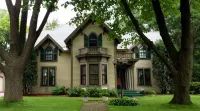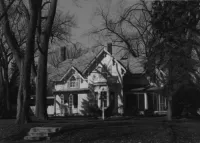Share what you know,
and discover more.
Share what you know,
and discover more.
Aug 01, 2018

-

- Marley Zielike
Gothic Minnesota Historic Homes National Registry
The Morningside neighborhood in Edina owes much of its land to an early pioneer who settled the area in the late 1850s. Jonathan Grimes, along with his wife Elizabeth, were the first to settle in the Edina Mills district when they opened up a small nursery in 1858. Known as the Lake Calhoun Nursery, the business supplied boulevard trees in the city of Minneapolis, especially the Catapla tree, which the Grimes introduced to Minnesota. Grimes later became the first president of the Minnesota State Horticulture Society. In 1859, Grimes bought the Waterville Mill (later renamed the Edina Mill), making much needed improvents to the dam and spillway. The mill supplied flour to the Fort Snelling Reserve during the Civil War and operated 24 hours a day during the early years of the war to keep up with demand. Grimes sold the mill in 1867, and two years later, built his new home.
Gothic Minnesota Historic Homes National Registry
The Morningside neighborhood in Edina owes much of its land to an early pioneer who settled the area in the late 1850s. Jonathan Grimes, along with his wife Elizabeth, were the first to settle in the Edina Mills district when they opened up a small nursery in 1858. Known as the Lake Calhoun Nursery, the business supplied boulevard trees in the city of Minneapolis, especially the Catapla tree, which the Grimes introduced to Minnesota. Grimes later became the first president of the Minnesota State Horticulture Society. In 1859, Grimes bought the Waterville Mill (later renamed the Edina Mill), making much needed improvents to the dam and spillway. The mill supplied flour to the Fort Snelling Reserve during the Civil War and operated 24 hours a day during the early years of the war to keep up with demand. Grimes sold the mill in 1867, and two years later, built his new home.
Aug 01, 2018
Gothic Minnesota Historic Homes National Registry
The Morningside neighborhood in Edina owes much of its land to an early pioneer who settled the area in the late 1850s. Jonathan Grimes, along with his wife Elizabeth, were the first to settle in the Edina Mills district when they opened up a small nursery in 1858. Known as the Lake Calhoun Nursery, the business supplied boulevard trees in the city of Minneapolis, especially the Catapla tree, which the Grimes introduced to Minnesota. Grimes later became the first president of the Minnesota State Horticulture Society. In 1859, Grimes bought the Waterville Mill (later renamed the Edina Mill), making much needed improvents to the dam and spillway. The mill supplied flour to the Fort Snelling Reserve during the Civil War and operated 24 hours a day during the early years of the war to keep up with demand. Grimes sold the mill in 1867, and two years later, built his new home.Posted Date
Sep 27, 2021
Historical Record Date
Aug 01, 2018
Source Name
Historic Homes of Minnesota
Delete Story
Are you sure you want to delete this story?
Mar 16, 1976
Mar 16, 1976

-

- Dave D
4200 W 44th St, Edina, MN - National Register of Historic Places
Excerpt from Statement of Significance: Jonathan Taylor Grimes was born in Leesburg, Loudoun County, Virginia on May 10, 1818. He came to Minnesota in 1855, In 1859 he purchased the Waterville Mill (later the Edina Mill) along with 160 acres of land in what is now northeast Edina. He built a new and better dam and made other improvements to the mill. During the Civil War, the mill ran day and night grinding out flour requisitioned by the government for the soldiers at Fort Snelling. Grimes wrote that the only chance he had to rest was on the journey home from the Fort. After delivering his flour, he would catch what sleep he could stretched out on the bottom of the wagon. Grimes sold the mill in 1869 and turned to farming. One of the most active pioneer horticulturists in the state, Jonathan Grimes started the Lake Calhoun Nursery on his land in northeast Edina in 1866 and operated it until his retirement in 1883. Grimes was a charter member of the Minnesota Horticultural Society. He served as its first president and continued in this office for many years. Grimes not only owned and operated the Lake Calhoun Nursery but also a large apple orchard and farm in northeast Edina. He introduced the first harvester used in Hennepin County. In his nursery, he grew the first Gingko tree in the state and one of the few in the country at the time. He also planted one of the first Catalpa trees in Minnesota. The large shade trees along Nicollet, Hennepin, Lyndale, and University Avenues in Minneapolis came from Grimes' nursery. The Jonathan Grimes House is one of the few remaining Gothic-style houses in the Minneapolis-St. Paul metropolitan area.
4200 W 44th St, Edina, MN - National Register of Historic Places
Excerpt from Statement of Significance: Jonathan Taylor Grimes was born in Leesburg, Loudoun County, Virginia on May 10, 1818. He came to Minnesota in 1855, In 1859 he purchased the Waterville Mill (later the Edina Mill) along with 160 acres of land in what is now northeast Edina. He built a new and better dam and made other improvements to the mill. During the Civil War, the mill ran day and night grinding out flour requisitioned by the government for the soldiers at Fort Snelling. Grimes wrote that the only chance he had to rest was on the journey home from the Fort. After delivering his flour, he would catch what sleep he could stretched out on the bottom of the wagon. Grimes sold the mill in 1869 and turned to farming. One of the most active pioneer horticulturists in the state, Jonathan Grimes started the Lake Calhoun Nursery on his land in northeast Edina in 1866 and operated it until his retirement in 1883. Grimes was a charter member of the Minnesota Horticultural Society. He served as its first president and continued in this office for many years. Grimes not only owned and operated the Lake Calhoun Nursery but also a large apple orchard and farm in northeast Edina. He introduced the first harvester used in Hennepin County. In his nursery, he grew the first Gingko tree in the state and one of the few in the country at the time. He also planted one of the first Catalpa trees in Minnesota. The large shade trees along Nicollet, Hennepin, Lyndale, and University Avenues in Minneapolis came from Grimes' nursery. The Jonathan Grimes House is one of the few remaining Gothic-style houses in the Minneapolis-St. Paul metropolitan area.
4200 W 44th St, Edina, MN - National Register of Historic Places
Excerpt from Statement of Significance:Jonathan Taylor Grimes was born in Leesburg, Loudoun County, Virginia on May 10, 1818. He came to Minnesota in 1855, In 1859 he purchased the Waterville Mill (later the Edina Mill) along with 160 acres of land in what is now northeast Edina. He built a new and better dam and made other improvements to the mill. During the Civil War, the mill ran day and night grinding out flour requisitioned by the government for the soldiers at Fort Snelling. Grimes wrote that the only chance he had to rest was on the journey home from the Fort. After delivering his flour, he would catch what sleep he could stretched out on the bottom of the wagon. Grimes sold the mill in 1869 and turned to farming.
One of the most active pioneer horticulturists in the state, Jonathan Grimes started the Lake Calhoun Nursery on his land in northeast Edina in 1866 and operated it until his retirement in 1883. Grimes was a charter member of the Minnesota Horticultural Society. He served as its first president and continued in this office for many years.
Grimes not only owned and operated the Lake Calhoun Nursery but also a large apple orchard and farm in northeast Edina. He introduced the first harvester used in Hennepin County. In his nursery, he grew the first Gingko tree in the state and one of the few in the country at the time. He also planted one of the first Catalpa trees in Minnesota. The large shade trees along Nicollet, Hennepin, Lyndale, and University Avenues in Minneapolis came from Grimes' nursery.
The Jonathan Grimes House is one of the few remaining Gothic-style houses in the Minneapolis-St. Paul metropolitan area.
Posted Date
Feb 16, 2022
Historical Record Date
Mar 16, 1976
Source Name
United States Department of the Interior - National Park Service
Document Source
Delete Story
Are you sure you want to delete this story?










